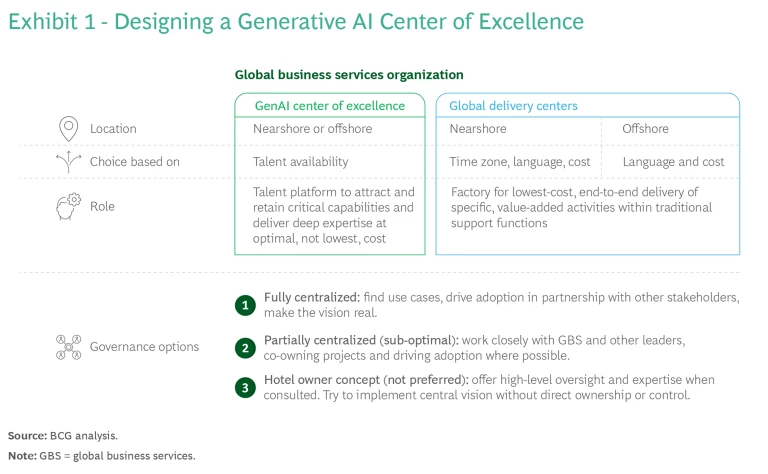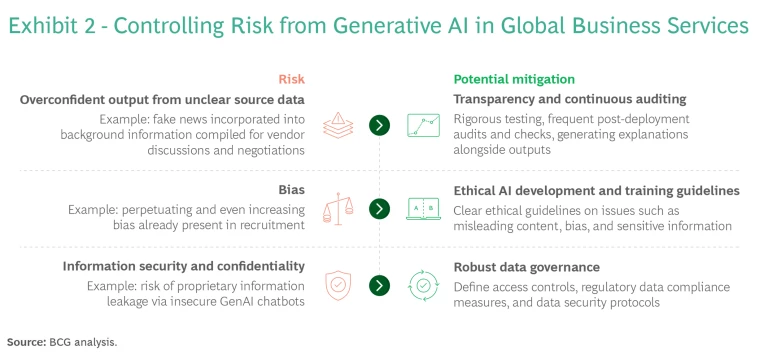Business support functions such as HR, accounting, and legal are at the center of the disruption caused by Generative AI , but the disruption does not stop there. As early adopters, these units can become change agents that help the whole organization apply this breakthrough technology .
The GenAI expertise that many organizations are quickly able to generate allows for the creation of a new business support organization—a GenAI center of excellence—that can drive firm-wide GenAI transformation while minimizing risk. This new center could be managed as part of the company’s global business services (GBS) organization.
As such, GenAI can significantly accelerate GBS’s transformation into a trusted partner for the business. The technology can liberate staff for more-strategic tasks, allowing GBS organizations to complete their shift from a collection of transaction-driven workbenches to functions that can add real value.
Generative AI can allow global business services organizations to complete their shift from a collection of transaction-driven workbenches to functions that can add real value.
Early in 2023, when BCG spoke to 44 C-suite leaders in large global companies about GenAI, some 40% said that their GBS function (among firms that had one) would be more affected by GenAI integration than any other part of the business.
For world-class GBS organizations to capture GenAI’s full potential, however, four major opportunities must build upon one other: initiate an internal transformation, create a platform, drive GenAI across the organization, and reduce risk while embedding innovation.
Opportunity 1: Initiate an Internal Transformation
GenAI will disrupt how work gets done in all major industries, but for large companies, GBS functions such as marketing , customer support, legal, finance, and human resources are the spearhead of GenAI opportunities. These departments can not only help drive productivity with GenAI but can also enhance customer and employee experience. Of the C-suite executives surveyed, 20% said they were already deploying GenAI on internal tasks, and 30% said they were running pilots.
The first and most obvious opportunity for larger companies would be to apply GenAI to the processes and activities inside the GBS function—or at least those that are fully owned and operated by it, such as order to cash, source to pay, or hire to retire.
GBS-managed customer care centers of one leading software firm and a large financial services company recently showed substantial benefits from introducing GenAI-driven conversational assistants (or “chatbots”) to respond to customer queries, auto generate user guidance and tutorials, and support swarming (bringing together a collection of experts) to resolve more-complex problems. These centers reported that their human experts needed to make 38% to 48% fewer calls to customers to resolve issues with these chatbots in place.
The long-term vision should always be to reinvent and transform the end-to-end process, even if some steps reside outside of GBS. GenAI must be embedded into the end-to-end delivery, business, and technology platforms.
There are tactical, big-win opportunities where GenAI can be quickly and effectively applied to specific steps in a process with moderate effort using preconfigured solutions.
Still, there are tactical, big-win opportunities where GenAI can be quickly and effectively applied to specific steps in a process with moderate effort using preconfigured solutions. For instance, organizations with GBS functions are already streamlining recruitment using GenAI to craft tailor-made job descriptions that target specific hiring needs and create text and visuals aimed at selected talent-sourcing channels. Other powerful yet straightforward GBS use cases include handling first-level communication with applicants, matching invoices inside finance functions, and providing first-level support for vendor or customer inquiries.
For these opportunities, platform vendors are already integrating GenAI into their products; switching them on offers a very straightforward way to launch the GBS GenAI journey.
Although GenAI deployments typically mean a step up in GBS employee productivity, users (usually employees needing to use central support services) may also find their experience substantially improved. Awkward, unpopular portals can be replaced by user-friendly self-help solutions that incorporate natural language processing—one reason why GenAI is such a step change in capability.
It also offers more foundational benefits. Partnerships with the rest of the business can be made stronger because GenAI can generate a quick proof of concept and then accelerate co-design without coding. The result is a faster, more flexible GBS that can quickly respond to new demands.
Opportunity 2: Create a Platform
The more fundamental opportunity for GBS is to leverage its early adoption of GenAI to build a process- and function-agnostic capability—the GenAI center of excellence—that can be deployed across all the functions and activities GBS owns or owns in part.
Units within GBS will naturally set up centers of expertise that will bundle development and delivery resources, driving adoption along various process chains. The nascent GenAI center of excellence will then support and maintain those use cases, becoming a platform that drives a more systematic, transformative approach to unleash GenAI’s immense potential across the GBS landscape.
By pooling capabilities into a fused center of excellence, companies can ensure the best talent will be centralized and drive a clear, enterprise-wide GenAI strategy that ensures that the services provided are aligned with one another to maximize the business benefits. This is a critical advantage: of the C-suite executives BCG spoke with, 48% said that a lack of talent was the most significant barrier to GenAI implementation—more than any other factor. This pooling of talent will also bring the GBS organization closer to the business, driving enterprise value and delivering results much faster than waiting for initiatives from multiple stakeholders. Strategic choices are important here. (See Exhibit 1.)

Opportunity 3: Drive GenAI Across the Organization
The next step change is for GBS to export its in-house success to the broader organization as a new, highly valuable service. Based on its own experience of successful GenAI use cases, it can find important opportunities and support the deployment of GenAI solutions elsewhere. Its detailed knowledge of data sourcing, training, and ongoing maintenance will be invaluable for units that lack that kind of practically acquired know-how. The new center of excellence will also monitor and support ongoing operations, offering assistance if, for instance, models or prompts—the queries that trigger a GenAI response—need adjustment to deliver maximum value.
At least initially, the center of excellence will work on tasks that connect to its GBS functions or have similarities in other ways. It could efficiently work on valuable upgrades in areas such as marketing and customer engagement, innovation, intellectual property screening, or operations and quality management. However, the center should quickly develop the expertise to become a flexible, general-purpose resource for GenAI across the organization—the first place managers call when they want to power up people or processes.
Some companies, by contrast, may centralize GenAI oversight in IT. Others may let it grow on top of a data science unit. GBS is a better home, however. GenAI is inherently multidisciplinary, and GBS has years of experience with that.
GenAI is inherently multidisciplinary, and GBS has years of experience with that.
Moreover, GBS units already have a partnership-focused, professional service philosophy, making them an ideal fit for this cross-organizational function. On a practical level, GBS already has legal, accounting, and risk management expertise.
Among its roles will be to facilitate creative GenAI deployments beyond the obvious use cases. One global automotive supplier that already uses GenAI in customer service is employing it to summarize online car reviews, allowing its editorial team to focus instead on identifying creative ways to engage customers and improve their experience. This solution summarized 11 years of reviews in a month, and the human editors gave it an approval rating of more than 80%.
Opportunity 4: Reduce Risk While Embedding Innovation
As GenAI spreads across the organization, there will quickly be a need for a single, robust approach to issues such as risk management, legal compliance, intellectual property, confidentiality, and cybersecurity. This approach needs to encompass more than just tools produced by the organization. It must also cover specialized new tools that may be brought in and the GenAI capabilities that will soon be added to many existing tools and platforms.
GBS is best placed to perform this increasingly complex and dynamic role. Its teams’ experience across the organization means that it will have the necessary critical mass and knowledge around sensitive enterprise and operational risk issues. Its deployments will also have been highly instructive; for instance, deployment within HR will require intensive work on legal and data privacy issues.

In short, GenAI shows great promise but presents unique risks that need to be proactively mitigated. (See Exhibit 2.) This final opportunity may not seem as disruptive as the earlier three, but as GenAI transforms business, the pitfalls will multiply. Risk management must be systematic, consistent, and effective.
Starting the Journey
These transformational opportunities will only become available to those who make a strong start on their GenAI journey. Five actions are critical to getting GBS on the launch pad:
- Identify the right people and skills to drive the GenAI process, bringing them together into a cross-functional and multidisciplinary team.
- Build a platform strategy that looks at processes from end to end, aligning people, processes, and technology to drive efficiency and scale. The good news is that the most-effective leaders in GBS have been successfully pursuing this strategy for years.
- Look for the most significant opportunities for GenAI, either in terms of generating value in end-to-end processes that the company already owns (or co-owns) or in contributing the most to the organization as a whole. These are the near-term big wins that will demonstrate the value of GenAI to the business—and prove that GBS can deliver.
- Start with useful pilot projects that build skills, which typically include, as a first step, activating GenAI features inside of existing platforms. Even though they may be small scale, it's vital to work with vendors to ensure that these early projects succeed.
- Understand the costs, because even though the productivity gains from GenAI can be huge, the impact will be reduced by the need to invest in tech platforms and applications. When looking at the financial case, it is the net outcome that should help determine which applications get rolled out.
Particularly in the first stages, there may be some setbacks, with projects potentially falling short of expectations. Before declaring an initiative to be a failure of generative AI technology, it’s vital to look honestly at your processes, decision making, and other factors that could have sabotaged the project. It’s also important to remember that creating a second version of a GenAI project is much easier than creating a second version of a conventional system. For instance, it is much easier to iterate prompts than to change code.
The GenAI Advantage
The vision of GenAI creating an empowered, energized GBS runs counter to a rival narrative, which is that GenAI will automate away many white-collar administrative functions, of which GBS is an example. This gloomy prediction comes in part because GenAI can often be deployed faster than previous automation technologies and with reduced integration effort. Its natural-language interfaces allow for “learn-as-you-go” approaches that interact more like a partner than a tool. It is also more robust than, say, robotic process automation (RPA), because it can stand up to process deficiencies and shortcomings in data quality. The incorrect narrative implies that GBS services can be further automated to improve productivity and quality, and the only reason this hasn’t happened yet is due to capital investment costs.
We have seen this type of prediction before. Outsourcing, RPA, and cloud computing were labeled as threats to GBS. And while these technologies did indeed change the tasks inside GBS, the fundamental result was that they allowed teams to reduce data entry jobs and use their knowledge to help the business in more valuable and strategic ways. For example, IT staff who used to run the first line of support were often redeployed to automation solutions or cybersecurity tasks.
Previous-generation automation like this has already allowed many GBS workers to increase the value they bring to their teams. GBS leaders can use the four GenAI opportunities covered here to deliver that same transformative effect throughout the organization.









